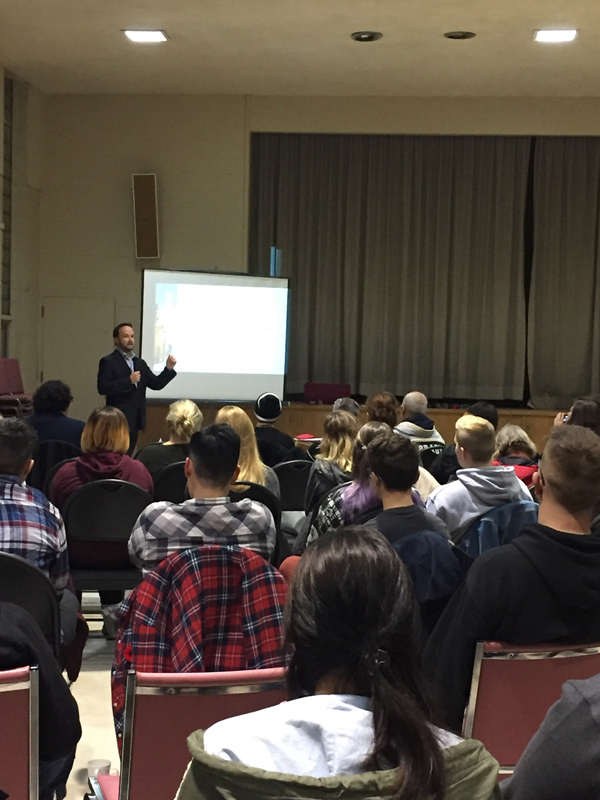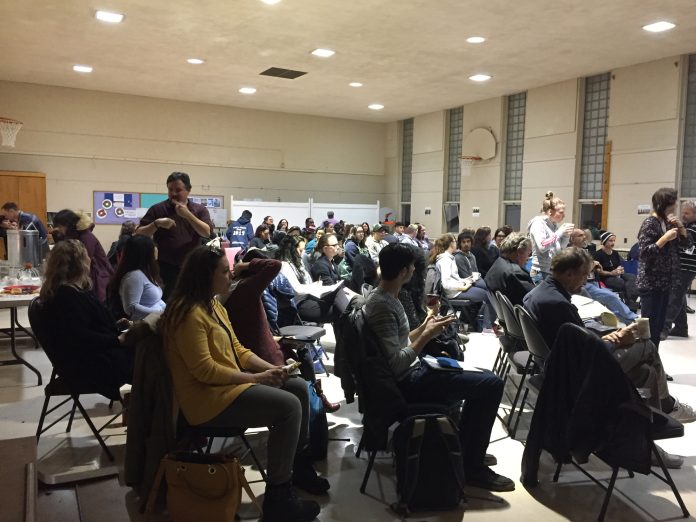By Bradley Turcotte –
Over 50 people attended a Naloxone demonstration at the Kitchissippi United Church (KUC) November 1 led by Mark Barnes, the Naloxone program champion pharmacist for the Ontario Minister of Health. He provided Naloxone kits, which have the potential to save someone during an opioid overdose, walked attendees through preparing and administering the shots, and answered a multitude of questions about addiction and opioids.
Prompted by the rise of opioid use and the presence of fentanyl and carfentanyl in street drugs, the event was organized by KUC’s Kristen Gracequist and Reverend Hilary Merritt.

Opioids include heroin, OxyContin, Percocet, and fentanyl, a synthetic opioid that is 50 to 100 stronger than morphine.
Mark describes taking fentanyl as putting a plastic bag over your head and tying it shut.
“As a pharmacist, we cannot do our job, administer proper pain management without opioids. They are a great medication when used properly,” says Mark, who operated the Westboro Pharmasave from 2007 to 2014 before founding Vanier’s Respect RX. “The problem is the same prescription meds used for epidurals and surgeries are being used on the streets of Ottawa right now. That’s the scary part.”
Ottawa Public Health estimates there are 71,000 opioid users in Ottawa, a portion of whom use opioids for non-medical purposes.
According to Mark, most urban centres in Canada claim heroin as their most used opioid, but in Ottawa, prescription opioids come before heroin, making Ottawa unique. Mark, who serves on the Ottawa Public Health Overdose Task Force, says Ontario consumes more opioids than anywhere else in the world.
“People do not use opioids chronically to get high. People use opioids to prevent pain. This pain could be physical. Most often this pain is mental… we need to treat addiction like a mental illness because it is,” says Mark.
Signs indicating an opioid overdose include slow or stopped breathing, blue lips and nails, gurgling or snoring sounds and tiny pupils. Unlike other drugs – which expand the pupil – opioids contract pupils to the size of pinpricks.
The naloxone kits provided take some assembly, as pre-loaded kits would be much more expensive, Mark says. In a pinch, the naloxone can be poured into a drug user’s nose rather than injected.
Attendee Gillian FitzGibbon is a self-described “opioid survivor” and divulges she was over-prescribed opioids after a knee injury.
“I was on, you name it Oxy, Percs, Dilaudid; I lived in a hospital bed in my living room for six months. All I could think about was killing myself,” Gillian says. “[It is] a systemic issue. These are the prescriptions coming from my family doctor who over and over and over again prescribed them. I didn’t know anything. I was in and out of withdrawal for so long… no one has ever said take a few and see how it goes. Ever.”
Gillian is now opioid-free and credits medical marijuana for easing her pain and helping her get off prescription medication.
Reverend Hilary is a youth and young adult minister and says organizing the event was the “socially responsible” thing to do as youth she works with have had friends, classmates and peers affected by the opioid crisis.
From prescriptions to illegal drugs cut with dangerous opioids, Kristen says it was an “eye opening” experience to learn it is not just street kids who are affected.
“It’s a very diverse group that this crisis is hitting. It’s not just one segment,” says Kristen.
For more information, visit stopoverdoseottawa.ca or visit Respect RX for a naloxone kit with a valid health card.
